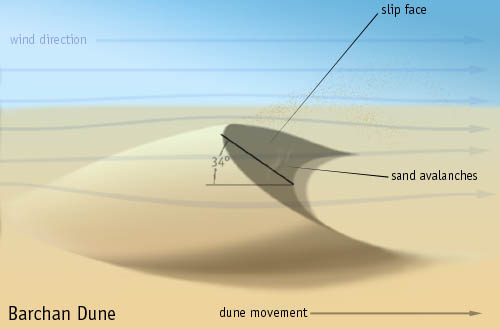
토플배경지식 : A barchan dune is an arc-shaped sand ridge, comprised of well-sorted sand.
This type of dune possesses two "horns" that face downwind, with the slip face (the downwind slope) at the angle of repose, or approximately 32 degrees. The upwind side is packed by the wind, and stands at about 15 degrees. Simple barchan dunes may stretch from meters to a hundred meters or so between the tips of the horns. Simple barchan dunes may appear as larger, compound barchan or megabarchan dunes, which may migrate with the wind. Barchans and megabarchans may coalesce into ridges that extend for hundreds of kilometers. As barchan dunes migrate, smaller dunes outpace larger dunes, bumping into the rear of the larger dune and eventually appear to punch through the large dune to appear on the other side.
The process seems to be similar to waves of light, sound or water that pass directly through each other; the detailed mechanism is, however, very different, being nonlinear.
These are known as solitons.
The dunes emulate soliton behavior but unlike solitons, the sand particles do not pass through each other.
When the smaller dune rear-ends the larger dune, the winds begin to deposit sand on the rear dune while blowing sand off the front dune without replenishing it.
Eventually, the rear dune has assumed dimensions similar to the former front dune which has now become a smaller, faster moving dune that pulls away with the wind. (Schwämmle & Herrmann, 2003)
책보다 자세하네~ also called barchan~~ 신기하다..
|